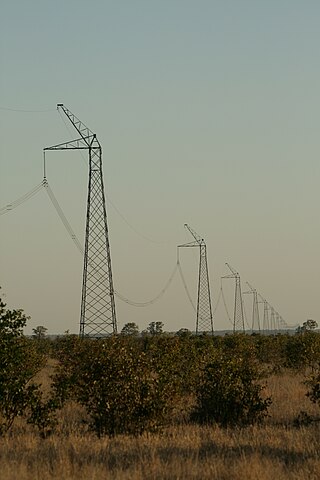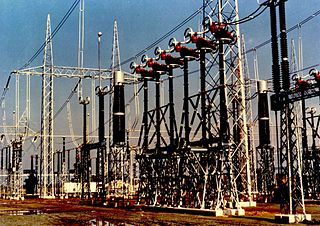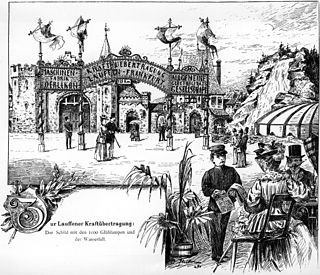
Electric power transmission is the bulk movement of electrical energy from a generating site, such as a power plant, to an electrical substation. The interconnected lines that facilitate this movement form a transmission network. This is distinct from the local wiring between high-voltage substations and customers, which is typically referred to as electric power distribution. The combined transmission and distribution network is part of electricity delivery, known as the electrical grid.

The Nelson River DC Transmission System, also known as the Manitoba Bipole, is an electric power transmission system of three high voltage, direct current lines in Manitoba, Canada, operated by Manitoba Hydro as part of the Nelson River Hydroelectric Project. It is now recorded on the list of IEEE Milestones in electrical engineering. Several records have been broken by successive phases of the project, including the largest mercury-arc valves, the highest DC transmission voltage and the first use of water-cooled thyristor valves in HVDC.

Cahora-Bassa is an HVDC power transmission system between the Cahora Bassa Hydroelectric Generation Station at the Cahora Bassa Dam in Mozambique, and Johannesburg, South Africa.

The Inga–Shaba EHVDC Intertie is a 1,700 kilometres (1,100 mi)-long high-voltage direct current overhead electric power transmission line in the Democratic Republic of Congo, linking the Inga hydroelectric complex at the mouth of the Congo River to mineral fields in Shaba (Katanga). It was primarily constructed by Morrison-Knudsen International, an American engineering company, with the converter equipment supplied by ASEA. Construction was completed in 1982 and it cost US$900 million. The scheme was, for many years, the longest HVDC line in the world.

High voltage switchgear is any switchgear used to connect or disconnect a part of a high-voltage power system. This equipment is essential for the protection and safe operation, without interruption, of a high voltage power system, and is important because it is directly linked to the quality of the electricity supply.

The 1891 International Electrotechnical Exhibition was held between 16 May and 19 October on the disused site of the three former Westbahnhöfe in Frankfurt am Main, Germany. The exhibition featured the first long-distance transmission of high-power, three-phase electric current, which was generated 175 km away at Lauffen am Neckar. As a result of this successful field trial, three-phase current became established for electrical transmission networks throughout the world.
China XD Group is a Chinese state-owned power engineering company and manufacturer of electrical equipment. The company was established in July 1959 and was formerly known as Xi'an Electric Machinery Manufacturing Company. It was also known as Xi'an XD, Xi'an Xidian, Xi'an Electric
The Vyborg HVDC scheme is a system of electricity transmission from the Russian power system to Finland, using high-voltage direct current. It consists of four 355 MVA (250 MW) back-to-back converter blocks, the first three of which were completed in the early 1980s and the last in January 2001. Much of the original converter equipment has been refurbished or modernised.

Hassan Farhangi is Professor Emeritus at BCIT School of Energy and Retired Director of Smart Microgrid Applied Research Team (SMART) at the British Columbia Institute of Technology (BCIT) in Burnaby, Canada, and an adjunct professor at the School of Engineering Science at Simon Fraser University. He is known for his pioneering work in the design and development of Canada's first Smart Microgrid on Burnaby Campus of British Columbia Institute of Technology from 2007 onwards, as well as for establishing and leading an NSERC Pan-Canadian Strategic Research Network in Smart Microgrids, consisting of a large number of research-intensive universities (NSMG-Net) in Canada from 2010 to 2016, which trained hundreds of graduate students and published numerous peer-reviewed research papers. Dr. Farhangi retired from his academic and research appointment at British Columbia Institute of Technology (BCIT) in Sept 2022 to pursue his personal research interests.
The Chandrapur–Padghe HVDC transmission system is an HVDC connection between Chandrapur and Padghe in the state of Maharashtra in India, which was put into service in 1999.
An HVDC converter converts electric power from high voltage alternating current (AC) to high-voltage direct current (HVDC), or vice versa. HVDC is used as an alternative to AC for transmitting electrical energy over long distances or between AC power systems of different frequencies. HVDC converters capable of converting up to two gigawatts (GW) and with voltage ratings of up to 900 kilovolts (kV) have been built, and even higher ratings are technically feasible. A complete converter station may contain several such converters in series and/or parallel to achieve total system DC voltage ratings of up to 1,100 kV.
A severity factor is established as a coefficient to assess the dielectric severity supported by a transformer winding considering the incoming transient overvoltage. It determines the safety margin regarding to the standard acceptance tests either in the frequency or time domain.

Vladimir Igorevich Gurevich is a prominent scientist, inventor and author in the field of electrical engineering with 15 books, more than 200 journal papers and over 100 patents on the topic of relays.
Marco Liserre is a University Professor in electrical engineering currently Head of the Chair of Power Electronics at the University of Kiel in Kiel, Germany. He was named a Fellow of the Institute of Electrical and Electronics Engineers (IEEE) in 2013. He is Deputy Director of Fraunhofer ISIT and Founder of ISIT@CAU, 2022. Prof. Liserre is also honored with the prestigious IEEE PELS R. David Middlebrook Achievement Award for the year 2023.
Dry Creek Power Station is a power station at Dry Creek in the northern suburbs of Adelaide, South Australia. It is owned and operated by Synergen Power, a joint venture of Engie and Mitsui. The power station has three open cycle gas turbines, each rated at 52MW. It was commissioned in 1973–1974 by the Electricity Trust of South Australia.
Commelec is a framework that provides distributed and real-time control of electrical grids by using explicit setpoints for active/reactive power absorptions/injections. It is based on the joint-operation of communication and electricity systems. Commelec has been developed by scientists at École Polytechnique Fédérale de Lausanne, a research institute and university in Lausanne, Switzerland. The Commelec project is part of the SNSF’s National Research Programme “Energy Turnaround”.
Birgitte Bak-Jensen is a Danish professor and researcher at the Department of Energy Technology at Aalborg University. Her research is aimed at intelligent energy systems and active electrical grids.
Maria Teresa Nunes Padilha de Castro Correia de Barros is a Portuguese electrical engineer whose interests include high voltage engineering, quality engineering of electrical power systems, and transients in power systems. She is a professor at the Instituto Superior Técnico, the engineering school of the University of Lisbon.
Western Australia, like other Australian states and high-income countries, is a heavy energy user by global standards.

C4-FN (C4-fluoronitrile, C4FN) is a perfluorinated compound developed as a high-dielectric gas for high-voltage switchgear. It has the structure (CF3)2CFC≡N, which can be described as perfluoroisobutyronitrile, falling under the category of PFAS, or per- and polyfluoroalkyl substances.









